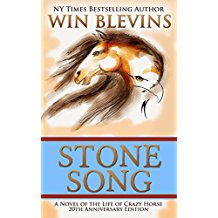Author Win Blevins’ extensive and passionate research is obvious in Stone Song: A Novel of the Life of Crazy Horse. Reading this novel carried me back to the early days of our country when native cultures clashed with land and gold seekers coming to the Northern Great Plains.
Crazy Horse, an Oglala Lakota Sioux, is one of history’s great warriors, perhaps best known for his role in defeating Custer at Little Big Horn.
The story covers most of Crazy Horse’s life, beginning in his youth when he was known as Light Curly Hair. He was often referred to as Strange Man, the result of a vision he had as a youth when he took certain vows that made him different than other young warriors. Crazy Horse considered himself a loner who wished to avoid politics. He rarely gave his opinion, but tried to stay true to his path.
The expansive novel offers views of Native People as a culture, giving the reader more understanding of the heart of a warrior. Time and again Crazy Horse’s people were betrayed and deceived by the white man. The Lakota and other Native Peoples watched their way of life dwindle to patches of barren land unsuitable for sustaining themselves. But it wasn’t only the white man who betrayed Crazy Horse; his fellow tribesmen also plotted against him.
Although the author claims the novel as a work of imagination, his in-depth research has created a vivid account of a prominent historical figure. At the end of the book, in the Afterword, Blevins claims that an author must “… see his subject not analytically but holistically, as in a dream. Then he must sing boldly the song of his dream….” Win Blevins has accomplished that goal in this novel. It is a masterpiece.



Growing up in Minnesota, we had only two tribes in the state: Sioux and Ojibwa (often mistakenly referenced as Chippewa.) The Ojibwa tribe was confined to the northern half of the state and the Sioux Nation (four individual tribes) was confined to the southern half. Both were treated unfairly, taken advantage of, restricted in their hunting areas. During the Civil War, the “Great Sioux Uprising” had far more impact on the Minnesota Territory than did the national war. Now I live in Arizona where there are 19 recognized tribes. They too have not prospered but they do have about 1/3 of the state lands. Unfortunately it is not prime acreage. I will have to read this book. It sounds like a good reference for my current WIP. Thanks for a most interesting review.
Thank you, Judith, for your in-depth comment. We have several tribes here in the Northwest, but they are mostly organized in confederations. We have several casinos in the area and the tribes have thrived. I don’t consider this method of making a living ideal, but at least it has made decent living conditions and college available.